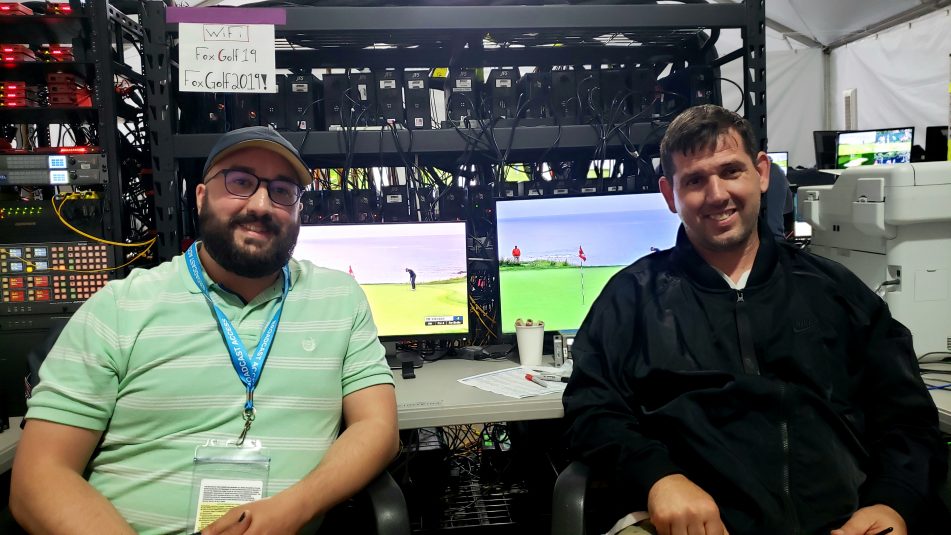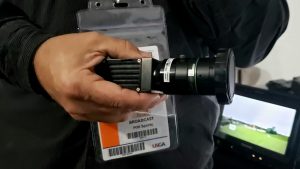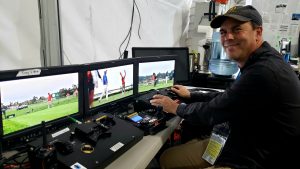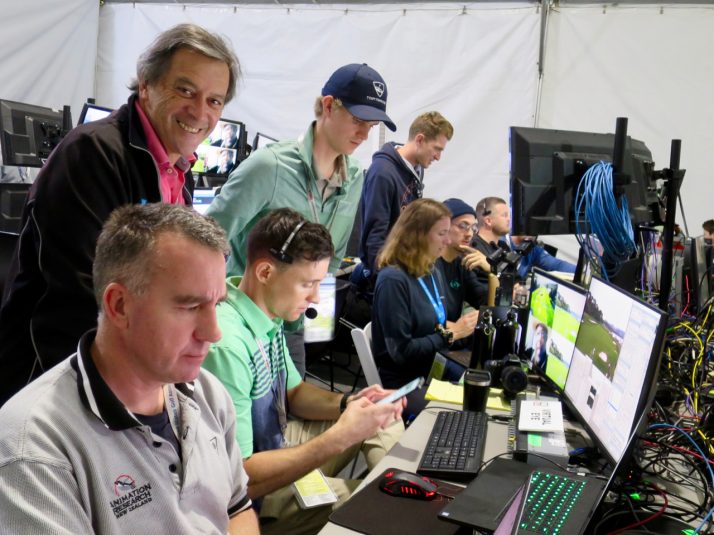Live From the U.S. Open: In Second Year, Technology Tent Finds Its On-Course Groove
Camera, audio, and RF support, robotics, and AR are housed away from the compound
Story Highlights
At last year’s U.S. Open in Shinnecock Hills, Fox Sports found itself facing a dilemma: there was simply not enough room in the compound for all the operational areas. As a result, a second area, dubbed the Technical Tent, was built about half a mile away. This year, the distance is a little longer (closer to a mile), but the goal is the same: to house camera, audio, and RF support as well as the robotics operators and AR operations nearer the course and in a single facility to minimize the need for production trailers and B units in the broadcast compound.
“The more we looked at it, that model made more and more sense,” says Mike Davies, SVP, technical and field operations, Fox Sports. “Now we may think about it for some other shows.”

Game Creek Video’s Tim Jobin (left) and Tommy Lynch oversee operations at the Technology Tent.
Tommy Lynch, technology lead, Game Creek Video, oversees the operations at the tent, alongside Tim Jobin, engineer, Game Creek Video. Davies says the bespoke facility gives the Game Creek team a chance to move beyond the truck facilities the company is known for.
“It underscores the four corners that Game Creek Video puts around this show,” he says. “Flypacks aren’t their forte, but it doesn’t mean they can’t do them when they have to.”
Lynch says having teams like all those involved with AR and shot tracking under one roof (or tent) works a lot better than being located in different production trailers.
“With all of the different entities that need to talk to each other,” he says, “it’s a lot easier to walk over and talk to somebody, as opposed to using a comms panel to try to find someone who may [be located elsewhere]. I believe you still can’t beat walking and talking to somebody in person.”
The tent is a little bit smaller than the one used last year, but the 40-50 people (and upwards of 70 when maintenance is in full swing working on cameras, lenses, and audio gear) have plenty of elbow room.
New this year in the tent, says Jobin, is support for the hole mics, more robotic operators, and quality control. A visit to the Technology Tent also gives a better understanding of some of the next-generation production tools that are constantly evolving, and the tent gives the breathing room to expand those operations.
“Pebble Beach is one of those courses that calls for everything, and you can just unload,” he explains.

The Dream Chip ATOM camera is being used in six bunkers at the U.S. Open.
For example, Jeff Silverman, president, Inertia Unlimited, is working with six Dream Chip ATOM one 4K mini 16 cameras, which weigh 123 g each and are being used as Bunkercams. Fujinon and Zeiss lenses are mounted to the cameras.
“The really neat thing is, it’s a 4K 60-fps HDR camera with dual outputs and genlock,” says Silverman. “They can also use a normal Sony RCP to paint the cameras, and the images are originating in 4K and then downconverted. It’s stunning that a 4K global imager [can fit] in a box this small.”

Inertia Unlimited’s Jeff Silverman at the controls of three POV cameras.
Silverman is also overseeing control of two X-Mo super-slo-mo cameras as well as a Sony P43 camera. Those drop cameras can be moved around the course and dropped in different locations on Holes 1, 5, 10, and 18; they operate in live mode and also shoot wide for slo-mo shots of golf swings.
“On the robotics, we’re dealing with some distances that can reach a few miles of fiber,” says Silverman, “but it’s all working great.”
According to Davies, the original plan was to rely on RF, but, from a practical standpoint, that didn’t work.
“With 124 other cameras on the course,” he explains, “we were able to predict where we wanted coverage and put in drops.”

Virtual Eye’s Ian Taylor (standing left) at the U.S. Open
Also located in the Technology Tent is the team from Virtual Eye, which this year used a Shotover G1 gyrostabilized gimbal platform from JITAcam. Virtual Eye Managing Director Ian Taylor notes that the Shotover rig is located on a Towercam that can be used for coverage on Holes 4, 6, 14, and 17 and provides a new angle for shot tracking.
A new development from Virtual Eye is that it can now put real-time AR graphics over live shots from any camera without the need for calibration.
“Now we can start to talk about doing AR with drones, blimps, and crane cameras,” says Taylor. “We know TV budgets are limited, so we are trying to design products in a way so that we can use the resources that are already here. Shotover is the one exception here at Pebble Beach.”
Virtual Eye is also once again using artificial intelligence to drive insertion of golf-hole maps, which will slide into the screen when players tee off on 10 of the 18 holes.
“The computer communicates to the radar system in the field,” says Taylor. “When the ball is hit, [the computer] knows to slide the graphics slab in from the side, adding the graphic to the replay without any operator needed. Tee shots that are covered live still have an operator so that he can do different things, but the automated system means that all of the shots will be able to have a slab.”
Taylor says working with the Fox team always spurs his company, and others, to stretch boundaries: “It’s quite cool working with them. Yes, sometimes something might not work, but it usually does.”
